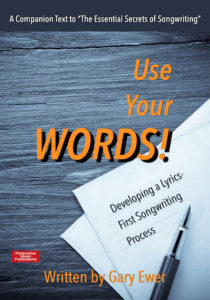It’s hard to think about song melodies without also thinking about the chords that we put underneath them. They go hand in hand. Historically (as in hundreds of years ago) music was all about the melody. Eventually (in the early 1600s) it was melody and bass line, with chords starting to fill in the middle.
 “Use Your Words! Developing a Lyrics-First Songwriting Process” is FREE with your purchase of “The Essential Secrets of Songwriting 10-eBook Bundle. $37 USD. Immediate Download.
“Use Your Words! Developing a Lyrics-First Songwriting Process” is FREE with your purchase of “The Essential Secrets of Songwriting 10-eBook Bundle. $37 USD. Immediate Download.
I wonder if that’s why I like melody-first songwriting processes. You can make a melody sound even better by the kinds of chords you choose. Chords-first processes can work, of course, but leaving the melody until after you’ve chosen chords means that you’re putting the thing that people hum and remember behind chords in importance. That’s trickier, though it can work.
Verse melodies can be challenging when comparing them to chorus melodies, for two important reasons:
- A verse melody usually wanders around more than a chorus melody. That’s because the chorus melody is typically hook-like, which means that it’s comprised of short melodic ideas that are repetitious. (Think “Born In the U.S.A.” as an example).
- The chords supporting a verse melody are often more tonally ambiguous than the chords supporting a chorus melody. Chorus chords are usually simpler, and focus more on the tonic chord than what we often find with a verse.
You can certainly have verse hooks, and some songs are really a hierarchy of various hooks where the verse hook isn’t as catchy or noticeable as the chorus hook (perhaps Michael Jackson’s “Bad” is a good example of this notion). But the main feature of a verse melody is not so much the hook, but how the ups and downs of the melody pair up nicely with the lyric.
The biggest challenge of writing a verse melody is writing something that captivates a listener enough to keep them listening, but still allows the eventual chorus hook to take centre stage.
With that in mind, here are some tips to consider as you practice writing verse melodies:
- Start your verse melody low in your vocal range. This gives you room to move higher when the chorus appears, and that’s a standard and important feature of most songs.
- Look for ways to stray from typical I-IV-V progressions as support for your verse melody. In a verse progression, it’s nice to either start on a non-tonic chord (like the vi-chord, or the ii-chord as we hear in “All My Loving” (Lennon & McCartney).
- Remember that repetition is an important part of verse melody structure. Though we tend to think of a chorus hook as a short, repeating figure, the verse also uses repetition, both exact and approximate. Listen for exact and approximate repetition of ideas in the verse of Adele’s “Rolling In the Deep” to get an idea of how important repetition can be to pulling in a listener and keep them listening.
- Verse melodies can work as chorus melodies. But because of the importance of a song’s chorus to the overall memorability and enjoyment of a song, it’s more a case where chorus melodies can work as verse melodies. If you’re using the same melody for both sections, get a good chorus happening first, and then make the production more transparent for your verse.
- Allow your verse melody to be more rhythmically interesting and intricate than the rhythms of your chorus melody. “Rolling In the Deep” is a good example of this feature as well. There are many quick syncopations and quicker rhythms in the verse when compared to the chorus. The chorus rhythms then simplify and lock into the hook, and that contrast is usually an important part of making the chorus shine.
The most important part of a verse is that it makes listeners seek out the chorus. Verse melodies start to move higher, and, along with clever production ideas, builds musical excitement. If your chorus melody sounds anticlimactic or otherwise uninteresting, it’s time to look back at the verse melody to see if it’s properly preparing the listener for that chorus.
 Written by Gary Ewer. Follow Gary on Twitter.
Written by Gary Ewer. Follow Gary on Twitter.
 Each eBook in “The Essential Secrets of Songwriting” 10-eBook Bundles shows you the fundamental principles that make great songs great. Comes with a Study Guide to show you the best way through all the materials.
Each eBook in “The Essential Secrets of Songwriting” 10-eBook Bundles shows you the fundamental principles that make great songs great. Comes with a Study Guide to show you the best way through all the materials.










